Useful information for parents and caregivers to keep their children safe when flying.
While the chance of an aviation accident is extremely small, turbulence can happen at any time. So parents should make sure their children will be safe during such a sudden and risky event.
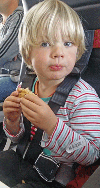
Ideally, every child has a seat of their own with some sort of robust restraint system.
The method of carrying and restraining infants and small children has not significantly changed since the beginning of passenger-carrying flights. In comparison, restraint methods in vehicles have undergone regular improvement.
New Zealand’s Civil Aviation Rules require that, as a minimum, a child or infant is held by an adult, with the child or infant secured by a safety belt attached to the adult’s safety belt (‘Supplemental Loop Belt’ – see below).
International crash studies indicate that there are safer options than the Supplemental Loop Belt in the event of severe turbulence, or an accident. Ideally, children should be in a seat of their own, held in an approved restraint.
Keep an eye on this webpage for updates on the issue.
In the meantime, here are the options for flying within New Zealand.
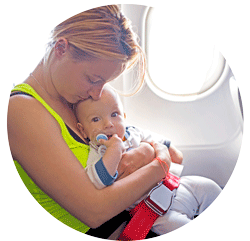
The Supplemental Loop Belt prevents the infant being bumped from the adult’s lap during heavy turbulence.
Airlines allow infants, up to the age of two, to sit on a parent’s lap using Supplementary/Supplemental Loop Belt.
This is a device providing an additional seat belt with a stitched loop through which the adult lap belt is passed. The seat belt is fastened around the adult, and the Supplemental Loop Belt is then separately fastened around the infant/child who sits on the adult’s lap.
The Supplemental Loop Belt stops the child being bumped from the adult’s lap during heavy turbulence. But some countries have different rules to New Zealand over the use of Supplemental Loop Belts, so check with all the overseas airlines you intend travelling on.
Some overseas airlines don't allow the use of a loop belt, but do allow you to hold the child on your lap. It's been proven that you're not capable of holding onto your child during heavy turbulence, so consider one of the options below.
Children under 20 kg (approximately 4 years) use car seats when they travel in a car. These children would also be better protected in the event of severe turbulence or an accident, if they used a car seat appropriate to their height and weight when they travel on aircraft.
Many parents may already have a car seat that can be used on an aircraft. However parents should always check with the airline regarding what car seats they allow, as they may have specific standards (see below), and size restrictions.
An approved car seat is fastened to a normal passenger seat, and can hold very young babies who use it ‘rear-facing’, then forward-facing, as they grow.
Most airlines require children aged two and over to have a passenger seat of their own anyway, so a car seat will provide additional safety and comfort, particularly on long flights. Another advantage of using a car seat on the aircraft is that it is one less thing that needs to be checked in!
Look for a label on the car seat saying it meets the following standards:

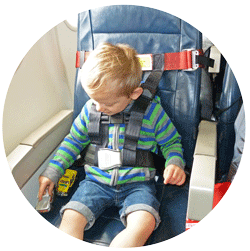
The CAA approves the CARES Child Harness because it links to both a standard airline seat belt and has an extra strap.
This harness is designed specifically for aviation use for children aged one year and older, who weigh 10 to 20 kilograms, and/or are up to a metre tall.
It links to both a standard airline seat belt and has an extra strap which is wrapped around the back of the airline seat.
This child harness is approved by the CAA, but check with your airline at the time of booking your tickets to make sure their aircraft accommodate them.
A CARES child harness provides a similar level of protection for the child as a car seat, but is a lightweight portable alternative.
Bassinets, attached to the airline cabin wall, provide comfort for both baby and adult during flight. But they are not meant to be used to secure the baby during take-off and landing. During those critical phases of flight, the infant will have to sit on their parent’s or caregiver’s lap with a Supplemental Loop Belt.
These seats have no built-in harness and use a standard aircraft seat belt. They are little more than plinths for children to sit on and are not an effective restraint.
Fabric slings, or manufactured infant carriers, are not suitable as a restraint. While they allow a child to be carried hands-free, they are carrying devices, not restraint systems. In typical impact tests, they have fallen well short of the required strength, and have ripped away from the adult.
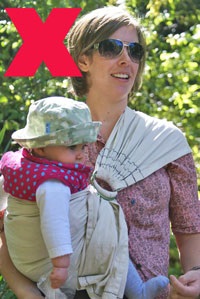 |
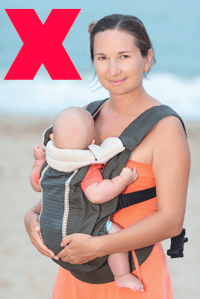 |
Neither fabric slings, nor manufactured front packs, are acceptable ways of securing your infant during the critical phases of flight.
If you have any questions about this topic, use our contact form, or email cabin.safety@caa.govt.nz